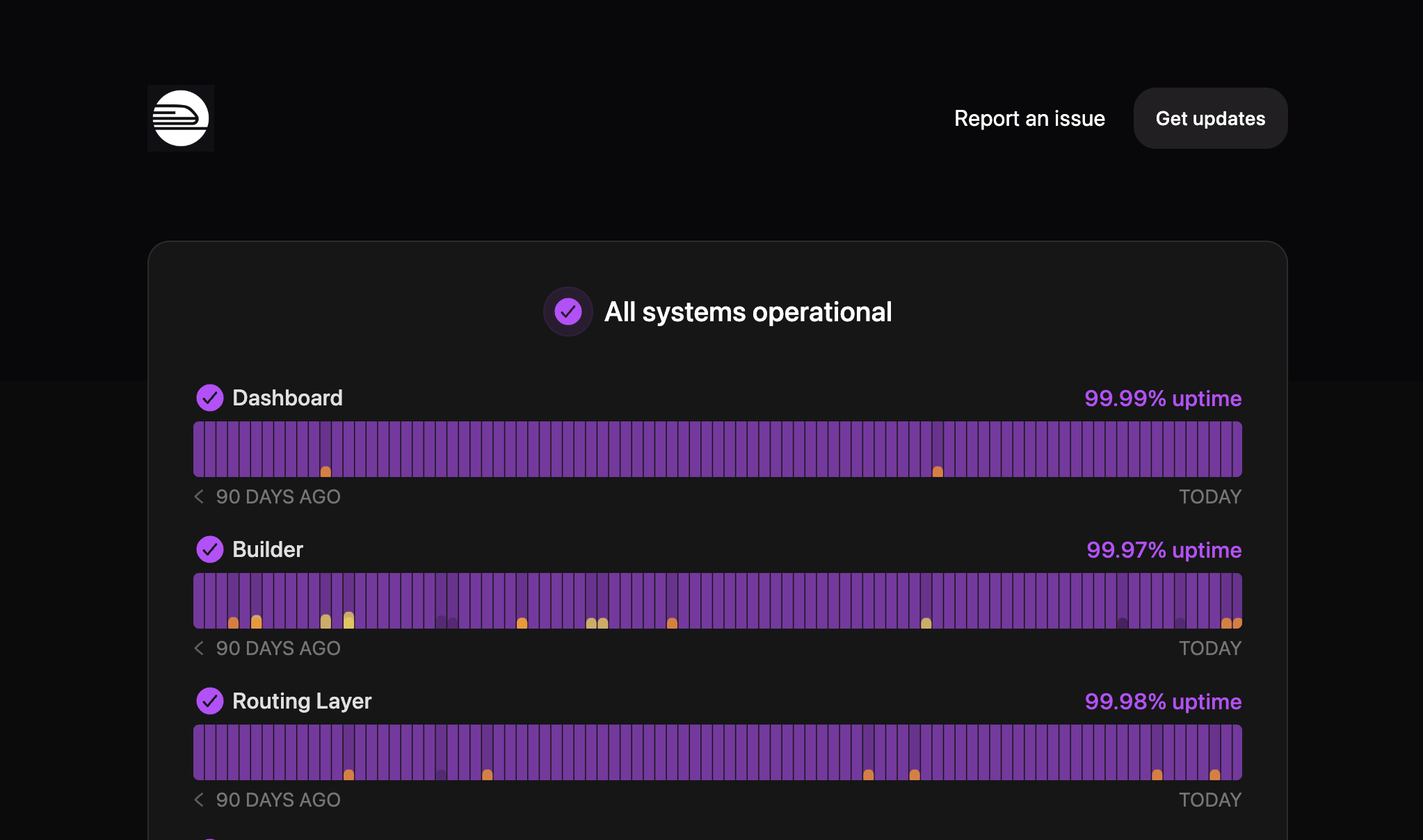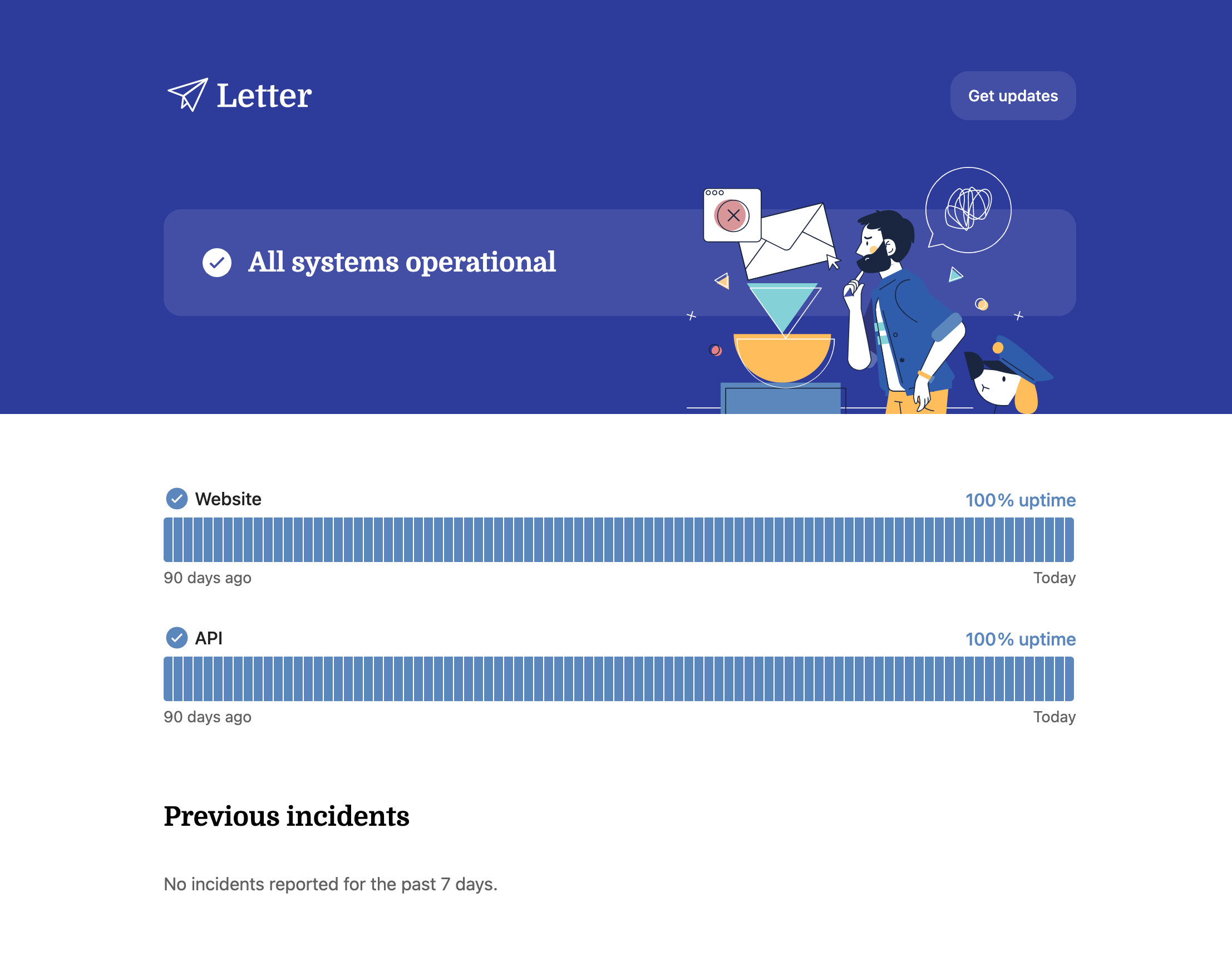Here’s Our Comprehensive Guide on How to Calculate Service Availability

Helpful Summary
- Overview: The article explains how to calculate service availability and the key metrics involved in it.
- Why you can trust us: Instatus has been instrumental in driving widespread success for top brands such as Dovetail, Wistia, Restream, and numerous others. We continuously track the operational status of services, make it easy to communicate incidents, and keep track of historical data.
- Why it matters: Calculating service availability helps systems meet uptime expectations, directly impacting reliability, user satisfaction, and adherence to SLAs.
- Action points: Learn the fundamentals of service availability, its key metrics, and how to calculate it.
- Further research: Check out our blogs for more insights on service availability, uptime, downtime, and other key metrics.
Looking to Understand and Calculate Service Availability?
Have you ever wondered how reliable your favorite apps, websites, or cloud services are? Have you experienced a service outage and wondered, "Why do they promise 99.99% availability?" Service availability represents more than just a statistic—it serves as a commitment to trust, dependability, and optimal performance.
Service availability is a major metric in IT operations, telecommunications, cloud computing, and software services. It tells you how much of the time a system, service, or infrastructure is operational within a period.
High availability guarantees customer satisfaction, upholds service level agreements (SLAs), and reduces downtime. This, in turn, helps prevent revenue loss.
But how exactly is service availability calculated? And what does "99.9% uptime" actually mean in practice? In this detailed Instatus guide, we’ll explore how to calculate service availability, the formula, the components involved, and real-world examples.
Why Listen to Us?
At Instatus, we provide a simple and effective platform for real-time communication during outages or incidents.
Our cutting-edge technology has served renowned organizations including Podium, Restream, and Railway, offering them a visually appealing status page where they can instantly update users about the current health of their services, providing transparency during downtimes.
Therefore, our status pages play a vital role in maintaining and improving service availability through transparency, effective communication, and incident management. This proactive communication reassures customers and reduces the impact of outages by keeping them informed. It also maintains trust even when availability is affected.
What Is Service Availability?
Imagine you’re using an online banking app or streaming your favorite show, and suddenly, it crashes. Encountering system downtime like this can be frustrating. It could be due to a system update or an unexpected failure, but what matters is: How often does it happen, and how long does it last?
That’s where service availability comes in. It refers to the percentage of time a system, service, or application is operational and accessible to users over a defined period. It’s a key measure of reliability and uptime, reflecting how often users can expect a service to function without interruptions.
High availability is important for businesses, especially in sectors where consistent access to services, such as online platforms or cloud services, directly impacts user satisfaction and operational performance.
Whether it’s your cloud storage provider, web hosting platform, or the software you rely on for work, service availability is the magic number that quantifies how often it’s up and running.
How to Calculate Service Availability
We know that service availability is important for several reasons. This includes maximizing user satisfaction in video streaming, guaranteeing uninterrupted group communication, and upholding reliability in safety-critical systems, where availability and dependability are more important than performance.
The big question is, "How is service availability measured?" You’ve likely heard promises like 99.9% availability or five nines (99.999%) uptime—but what do these numbers represent, and how are they calculated?
What Does "99.9% Availability" Mean?
Many companies tout 99.9% uptime for their services, but have you ever considered what that figure actually means? How much downtime does that seemingly small percentage allow?
Let’s do the math!
- 99.9% availability means the service can be down for up to 0.1% of the time.
- For a year, that’s 0.1% of 525,600 minutes, which equals 525.6 minutes.
- That’s roughly 8.76 hours of downtime per year.
A guarantee of 99.9% uptime translates to around 9 hours of downtime annually. Is that an acceptable amount? And what if we aim for five nines (99.999%) instead?
Any level of uptime below 99% is generally considered undesirable. However, it's also essential to recognize that an uptime percentage above 99% doesn't necessarily guarantee optimal performance. Each additional “nine” to service availability percentage can make a significant difference in a system's overall reliability.

Achieving a service availability of 99.999% (five nines) is considered exceptional. Exceeding this level is truly remarkable! Therefore, when developing applications, strive for a minimum availability of 99.999% in order to ensure customer satisfaction.
The chart shows why vendors strive to deliver products with five nines availability while customers seek SLAs that guarantee 99.999% uptime for their services. The stakes are high when it comes to maintaining service availability.
Important Metrics for Calculation of Service Availability
When measuring and monitoring service availability, several key metrics provide insights into the health and reliability of a service. These metrics help organizations maintain high uptime, track performance, and ensure service level agreements (SLAs) are being met. Below are the most important service availability metrics:
1. Downtime
Downtime is the period when a service is unavailable or non-operational. It includes both planned (e.g., scheduled maintenance) and unplanned (e.g., outages or system failures) downtime.
Downtime duration gives you several insights. It can indicate how long it takes for a backup system to kick in and also help evaluate the efficiency of incident response. You can calculate downtime for various time frames based on your specific needs.
The way to improve availability is by minimizing downtime. Tracking helps identify the causes of failures and optimize systems to prevent future disruptions.
With a tool like Instatus, customers and teams can understand system performance at a glance. We keep users in the loop by highlighting periods of downtime, maintenance, or incidents, painting a complete picture of your service’s reliability.
Whether scheduled maintenance or unexpected outages, Instatus ensures everyone stays informed, building trust through transparency and fostering confidence in your service’s stability.
2. System and User Uptime
Uptime refers to the total time a service or system is operational and accessible to users in a defined period. It’s the core metric that determines service availability. High uptime directly reflects reliable services, helping meet user expectations and SLA commitments.
But the system being up doesn't guarantee customer service. When resources are lacking, certain users may experience downtime. User uptime is equally important as it measures uptime for each user or group of users.
Instatus gives a comprehensive perspective of your service's uptime, letting teams and customers monitor system stability and real-time performance. Our platform is made to show uptime metrics in a way that’s clear and easy for everyone to understand.
3. Mean Time Between Failures (MTBF)
MTBF measures the average time between one failure and the next. It’s calculated by dividing the total operational time by the number of failures.
MTBF = Total Uptime/ Number of Failures
A higher MTBF means that a service is more reliable. This metric helps assess system stability and identify areas where failure rates can be reduced.
4. Mean Time to Resolution (MTTR)
MTTR refers to the average duration required to address and resolve a failure or to restore service following an interruption. It includes the time spent detecting, diagnosing, and rectifying the issue. This makes it a comprehensive measure of operational efficiency and reliability.
MTTR = Cumulative Downtime/Number of Incidents
Lower MTTR indicates faster recovery times, which helps maintain higher availability. It's a vital metric for assessing the efficiency of incident response processes.
5. Frequency of Outages
This metric measures how often there are service outages within a specific time frame. It helps you understand how resilient your system is overall. Frequent outages may indicate underlying systemic issues that require attention.
The Service Availability Formula
To calculate service availability, you start by establishing a clear service availability or agreed service time (AST) for a specific reporting period. Then, keep track of any downtime (DT) during that period. Finally, calculate the percentage of time your service was available by subtracting the downtime from the AST. This will give you an exact number for your service's availability.
It is calculated by using this equation:
Availability (%) = (Agreed Time - Downtime/Agreed Service Time) × 100
For example, if AST is 100 hours and downtime is 3 hours, then the availability is:
(100-3)/100*100 = 97%
Agreed service time refers to the anticipated duration during which a service will be active and available for use. In the context of an SLA, if it is specified that users should have access to the system from 10:00 a.m. to 8:00 p.m. on workdays, then the agreed service time would be 10 hours per workday.
Steps to Calculate Service Availability
Step 1: Define the Agreed Service Time
The first step is to calculate the AST, which represents the total time the service is expected to be functional per the SLA. The AST doesn't necessarily correspond to the total time on the calendar, as not all services need to be available 24/7. It can vary depending on the service’s unique attributes.
For example:
- If the service is required to be available 24/7 for one month, the AST would be 30 days × 24 hours/day = 720 hours
- If the service is only required to be available from 8 a.m. to 5 p.m. on weekdays, the AST would be 9 hours/day × 5 days/week × 4 weeks = 180 hours/month
Step 2: Measure Downtime
The next step is determining the total downtime experienced during the agreed service time. You can track downtime using various monitoring tools, logs, or manual tracking systems. Recording downtime as accurately as possible ensures precise availability calculations.
For example:
- Your website is expected to be available 24/7, but a server failure makes it inaccessible to users for 2 hours on a busy shopping day. Then the downtime is 2 hours.
Step 3: Calculate Uptime
When you have identified the amount of time your system was down, you can then determine the uptime, which is the actual duration the service was accessible during the agreed service period.
The formula for calculating uptime is: Uptime = Agreed Service Time − Downtime
For example:
- If the AST for the month is 720 hours and downtime is 4 hours, the uptime would be 720 hours − 4 hours = 716 hours
Step 4: Apply the Formula
Now that you have both the uptime and agreed service time, you can calculate the service availability percentage using the following formula:
Availability (%) = (Uptime/Agreed Service Time) × 100
So, for example, suppose the AST is 720 hours, and the uptime is 716 hours. Using the formula, we get:
Availability (%) = (716/720)×100 = 99.44%
Thus, the service availability for the month is 99.44%.
Step 5: Compare With SLAs
Once you’ve calculated your availability percentage, compare it with the agreed-upon availability outlined in your SLA. SLAs often specify a minimum acceptable availability percentage (99.9%). If the calculated availability is below this threshold, you should investigate the reasons for downtime and see if you can prevent it from happening in the future.
Measure Service Availability With Instatus
Calculating service availability is vital for ensuring that your system meets the expected performance levels defined in the SLA.
By defining the agreed service time, tracking downtime, calculating uptime, and applying the formula, you can monitor your service availability. This will allow you to improve your reliability, customer satisfaction, and general system health.
To calculate service availability with Instatus, you can use our real-time monitoring and incident tracking features. We help track both uptime and downtime, automatically recording when a service is experiencing issues.
Instatus simplifies this process by providing a visual status page and ongoing reports. This allows teams to quickly review their availability metrics and ensure they meet their SLA goals.
Don't miss out! Sign up today to get your own Instatus status page.
Get ready for downtime
Monitor your services
Fix incidents with your team
Share your status with customers





